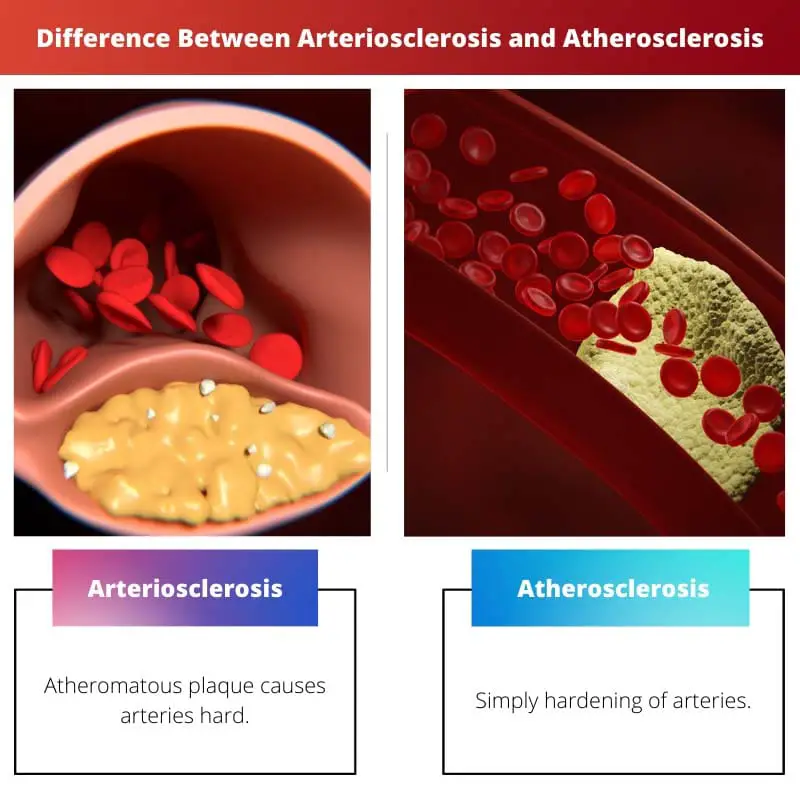Arteriosclerosis refers to thinning of arteries, and later it gets hardened. This stops the circulation of blood in the body. Atherosclerosis is a type of Arteriosclerosis.
This decreases the circulation of blood in the body. Arteriosclerosis depends on the size of the arteries. Atherosclerosis can harden large arteries.
Key Takeaways
- Arteriosclerosis is a general term for the hardening and thickening of the arterial walls. At the same time, atherosclerosis is a specific type of arteriosclerosis involving plaque buildup in the arterial walls.
- Arteriosclerosis is associated with ageing, while atherosclerosis is associated with unhealthy lifestyle choices such as smoking and a high-fat diet.
- Arteriosclerosis can lead to various health problems, such as high blood pressure, while atherosclerosis can lead to more serious conditions, such as heart attack and stroke.
Arteriosclerosis vs Atherosclerosis
Arteriosclerosis is a term that refers to the thickening and hardening of the arterial walls. Atherosclerosis is a specific type of arteriosclerosis and occurs when plaque, which is made up of cholesterol, fatty substances, and other materials, builds up on the inner lining of the artery walls.

Arteriosclerosis can occur when blood vessels start getting thick and then block blood circulation to body organs. Arteries circulate blood to the organs of the body. Arteries lose their flexibility.
The elasticity goes away and then blocks the path of blood circulation, which later hardens the arteries in the body.
Atherosclerosis can occur in a body when the person is experiencing a high level of cholesterol in the body. Even high levels of triglyceride can lead to Atherosclerosis.
Smoking is also a factor that can lead to Atherosclerosis. The symptoms can start with chest pain, vision problems, or ineffective talking.
Comparison Table
| Parameters of Comparison | Arteriosclerosis | Atherosclerosis |
|---|---|---|
| Definition | Atheromatous plaque causes arteries hard | Simply hardening of arteries |
| Aging | Yes | No |
| Plaque Buildup | No | Yes |
| Cholesterol level | High | Does not matters |
| Genes | Affects | Does not affects |
| Heart Problems | Yes | No |
What is Arteriosclerosis?
This occurs when blood flows get restricted, and then fat cholesterol starts getting built on the walls of the arteries. This hardens the arteries and can affect mostly the heart. Arteriosclerosis leads to Atherosclerosis. This can cause many more diseases especially related to the heart.
Heart disease is the most happening disease. There are types of Arteriosclerosis that depend on the sizes of arteries. Atherosclerosis can harden large arteries. Moenckeberg medial calcific sclerosis can harden medium-sized arteries.
This can occur when blood vessels start getting thick and then block blood circulation to body organs. Arteries circulate blood to the organs of the body. Arteries lose their flexibility. The elasticity goes away and then blocks the path of blood circulation, which later hardens the arteries in the body.
This disease has no symptoms. Even the kidney fails in this disease. A person can even lose vision in one eye.
High blood pressure can even be a symptom of the disease. It can lead to obesity. A person with this disease can cause high blood pressure and high cholesterol.
Diabetic persons are prone to this disease. A person belonging to a family who has a history of heart disease can cause this disease. Smoking can also cause this disease.

What is Atherosclerosis?
The reason for this disease is still unknown. It happens in childhood or even starts in late childhood. There is a formation of plague in the beginning. Endothelium gets damaged later. This can occur in the body when the person is experiencing a high level of cholesterol in the body.
Even high levels of triglyceride can lead to Atherosclerosis. Smoking is also a factor that can lead to Atherosclerosis. This disease does not have symptoms, so a person cannot identify the problem in the body at an early stage.
The symptoms give a signal when arteries are already mostly thin. The symptoms can start with chest pain, vision problems, or ineffective talking. The person has to undergo various medical tests to evaluate if the person has Atherosclerosis.
A person is told to take an MRI test, ultrasonography, and electrocardiogram. The first thing is to take care of the blood sugar and cholesterol in the body. The person has to maintain the levels in the body.
The person is a smoker. Then the person has to seize smoke. The physician gives antiplatelet medicines. These medicines prevent the body from blood clotting. The person has to eat a balanced diet and avoid eating oily foods.

Main Differences Between Arteriosclerosis and Atherosclerosis
- Arteriosclerosis is a condition in which arteries get hardened due to atheromatous plaque, and Atherosclerosis is a condition of hardening of arteries.
- Arteriosclerosis can occur due to aging but not Atherosclerosis.
- Plaque buildup can lead to Atherosclerosis but not Arteriosclerosis.
- Atherosclerosis can occur due to high cholesterol levels, but Arteriosclerosis cannot occur due to high cholesterol levels.
- Arteriosclerosis happens due to genes, but genes are not a factor in atherosclerosis.
- Heart problems can occur due to Atherosclerosis but not Arteriosclerosis.

- https://www.cabdirect.org/cabdirect/abstract/19451401587
- https://www.ahajournals.org/doi/abs/10.1161/hc0902.104353

The information about arteriosclerosis and atherosclerosis provides a comprehensive understanding of the impact of these conditions, particularly on cardiovascular health. It’s essential to prioritize preventive measures and early intervention.
Thank you for highlighting the significance of early intervention. It’s crucial for individuals to have knowledge about these conditions and adopt proactive health measures.
I completely agree. Identifying the signs and risks associated with arteriosclerosis and atherosclerosis can lead to better health management and improved outcomes.
The comprehensive overview of arteriosclerosis and atherosclerosis underscores the critical role of lifestyle factors and genetics in their development. Adopting a holistic approach to health management is paramount.
Thank you for emphasizing the importance of a holistic approach. It’s crucial for individuals to proactively address lifestyle factors and genetic influences to safeguard their cardiovascular health.
Absolutely, a holistic approach to health management, encompassing lifestyle modifications and regular health screenings, is essential for mitigating the risks associated with arteriosclerosis and atherosclerosis.
The distinction between arteriosclerosis and atherosclerosis is clearly delineated, emphasizing the diverse health implications of each condition. It’s crucial to recognize the warning signs and risk factors associated with both of them.
It’s evident that understanding the differences between arteriosclerosis and atherosclerosis can empower individuals to make informed decisions about their health and well-being.
Absolutely, raising awareness about the warning signs and risk factors of arteriosclerosis and atherosclerosis is vital for promoting health literacy and proactive healthcare practices.
The clear distinction between arteriosclerosis and atherosclerosis provides valuable insights into the diverse risk factors and health implications associated with these conditions. Understanding the significance of lifestyle choices and genetic predispositions is instrumental in promoting cardiovascular health.
Absolutely, acknowledging the impact of lifestyle choices and genetic predispositions on arteriosclerosis and atherosclerosis can empower individuals to make informed decisions about their health.
The detailed information about arteriosclerosis and atherosclerosis underscores the nuanced nature of these conditions and their potential implications for overall health. It’s essential for individuals to prioritize cardiovascular wellness through preventive measures.
Absolutely, taking proactive steps to prioritize cardiovascular wellness is crucial, especially in understanding the distinct impact of arteriosclerosis and atherosclerosis on heart health.
Thank you for outlining the importance of preventive measures. Recognizing the impact of arteriosclerosis and atherosclerosis can lead to positive health outcomes.
The explanations about arteriosclerosis and atherosclerosis shed light on the potential health risks associated with these conditions. It’s evident that lifestyle choices and genetics play significant roles in their development.
Absolutely, the influence of lifestyle and genetic factors in arteriosclerosis and atherosclerosis highlights the need for a holistic approach to preventive care.
The insights provided about arteriosclerosis and atherosclerosis offer valuable knowledge about the complexity of these conditions and their potential impact on overall health. It’s essential for individuals to prioritize preventive care measures.
Arteriosclerosis and atherosclerosis are both important conditions that can lead to serious health problems. It’s essential to understand the differences between these conditions to prevent them.
I agree with you, it’s crucial for everyone to be aware of these conditions and their potential impact on health.
Thank you for the informative explanation. Understanding arteriosclerosis and atherosclerosis can help in taking proactive steps for a healthier lifestyle.
The comparison table on arteriosclerosis and atherosclerosis provides a clear overview of the differences between the two conditions, emphasizing key factors such as plaque buildup, cholesterol levels, and genetic influences.
I appreciate the detailed breakdown of the differences. It’s important to recognize the distinct characteristics of arteriosclerosis and atherosclerosis when assessing cardiovascular health.
Yes, the comparison table offers valuable insights into these conditions, highlighting essential elements that contribute to arteriosclerosis and atherosclerosis.
The descriptions of arteriosclerosis and atherosclerosis highlight the multifaceted nature of these conditions and their potential impact on vital organs. Knowledge about the signs and symptoms is crucial for early detection and intervention.
I agree. Early detection and intervention are pivotal in minimizing the long-term effects of arteriosclerosis and atherosclerosis on health.